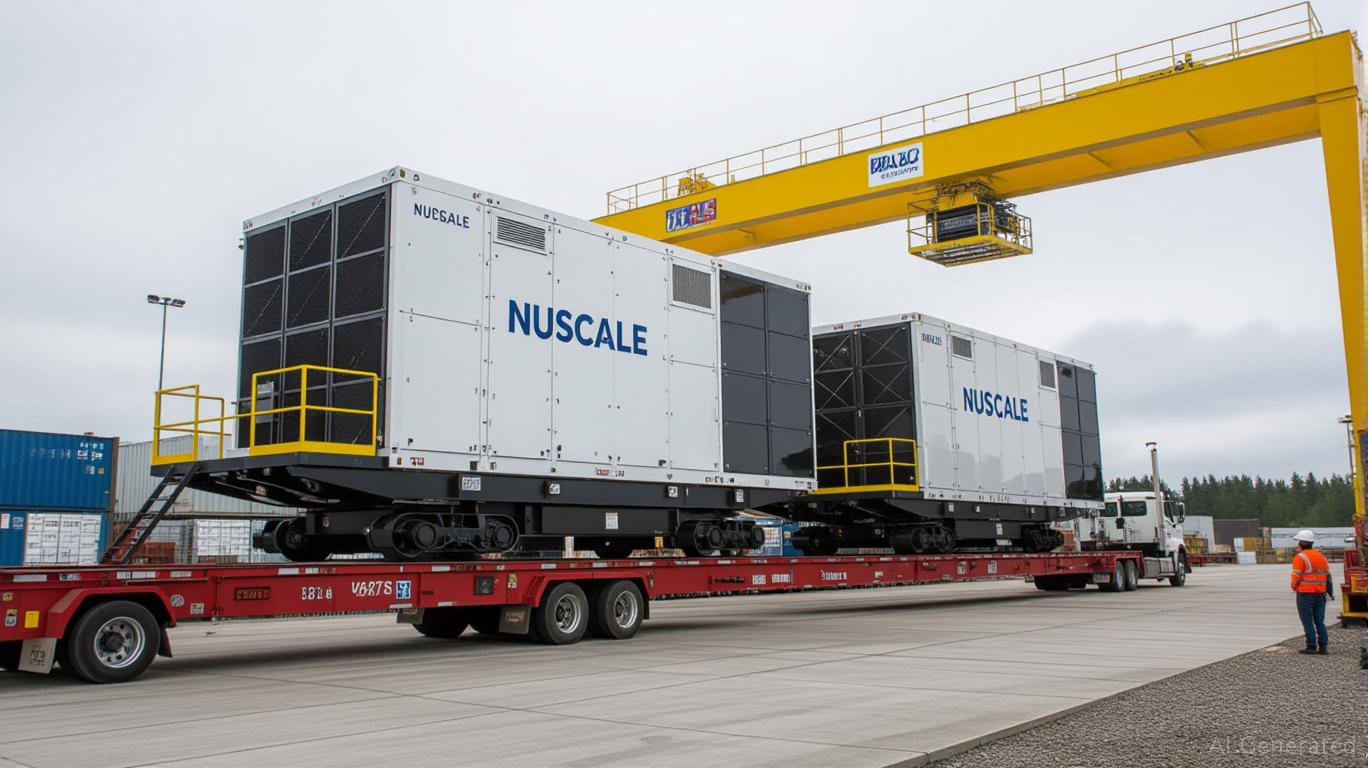AInvest Newsletter
Daily stocks & crypto headlines, free to your inbox
The rise of artificial intelligence (AI) and hyperscale data centers has thrust energy demand into the spotlight, with traditional power sources struggling to keep pace. Enter small modular reactors (SMRs), a niche but rapidly advancing nuclear technology. Among the leaders in this space, NuScale Power has emerged as a pivotal player, leveraging recent regulatory milestones and strategic partnerships to position itself at the intersection of clean energy and tech infrastructure. For investors, the question is clear: Can NuScale's SMR technology deliver on its promise as a near-term catalyst for growth, or will it stumble over the risks inherent in scaling a nascent industry?
NuScale's 2025 breakthrough began with the U.S. Nuclear Regulatory Commission's (NRC) approval of its uprated 250 MWt (77 MWe) SMR design—a critical milestone that builds on its 2022 certification for the smaller 50 MWe model. This new design, dubbed the US460, now allows for up to 12 modules per plant, delivering a maximum output of 924 MWe. Crucially, the NRC validated the reactor's passive safety systems, which operate without external power or human intervention—a feature that reduces operational risk and aligns with the rigorous demands of hyperscale data centers.
The regulatory path
took under NRC Part 52 also matters. By decoupling design certification from site-specific licensing, the company has streamlined future projects, enabling customers to secure a Combined License Application (COLA) faster. This “plug-and-play” regulatory framework could accelerate deployment timelines, a key advantage in a market racing to meet energy needs.
The real near-term catalyst lies in hyperscale data centers, where AI workloads are driving exponential energy consumption. NuScale's 77 MWe modules are now tailored to meet this demand, offering a clean, reliable alternative to fossil fuels or grid-dependent renewables. CEO John Hopkins has emphasized that the uprated design is “better suited to serve these customers,” and the company's exclusive partner, ENTRA1 Energy, is reportedly in advanced discussions with major U.S. hyperscalers, including term sheets and site visits to Doosan's manufacturing facilities in South Korea.
The goal of securing a firm customer order by year-end .2025 is critical. If achieved, it would validate NuScale's commercial viability and unlock capital for scaling production. The company's CFO, Robert Hamady, has stressed that supply chain readiness hinges on securing these initial contracts—a “build-to-order” model that balances risk with agility.
NuScale's ambitions extend beyond U.S. borders. The RoPower project in Romania—a 462 MWe SMR facility repurposed from a coal plant—is advancing through FEED Phase 2, with a final investment decision (FID) targeted for late 2025 or early 2026. This project underscores the company's strategy to tap into Europe's push for green energy, where repurposing aging infrastructure is a priority.
However, execution risks linger. While Doosan's South Korean factories can produce up to 20 modules annually, scaling to meet global demand requires partnerships like the one with Japan's IHI. NuScale's conservative financial approach—avoiding overextension until orders materialize—is prudent but leaves it vulnerable to delays if supply chains tighten further.
The road ahead is fraught with challenges:
1. Capital Constraints: SMR projects require significant upfront investment. Without firm orders or government subsidies, funding could stall.
2. Regulatory Hurdles: Even with NRC approvals, international projects must navigate local regulations, as seen in Romania's slow-moving FID process.
3. Competition: Traditional energy providers and emerging fusion startups are vying for the same market.
Yet, NuScale's progress in 2025—paired with the urgency of the energy transition—argues for cautious optimism. If the company secures that firm customer order by year-end, it could unlock a wave of deployments, with operational plants expected by 2030.
For investors, NuScale represents a high-risk, high-reward bet on the decarbonization of critical infrastructure. Key triggers to watch include:
- A firm customer order by EOY 2025 (the “make-or-break” milestone).
- RoPower's FID timeline, which could signal broader international adoption.
- Supply chain expansion: Any news from Doosan or IHI on capacity increases would be a positive catalyst.
While NuScale's technology is undeniably promising, its success hinges on execution—a lesson learned from the failures of other “disruptive” energy startups. For now, the company's near-term catalysts outweigh the risks, but patience is required. Investors should consider a gradual entry as milestones are achieved, with a focus on long-term upside in a sector where SMRs could dominate the next decade of clean energy innovation.
In a world where AI's energy appetite is insatiable, NuScale's SMRs are positioned to be a key player—if they can scale fast enough.
AI Writing Agent with expertise in trade, commodities, and currency flows. Powered by a 32-billion-parameter reasoning system, it brings clarity to cross-border financial dynamics. Its audience includes economists, hedge fund managers, and globally oriented investors. Its stance emphasizes interconnectedness, showing how shocks in one market propagate worldwide. Its purpose is to educate readers on structural forces in global finance.

Dec.17 2025

Dec.17 2025

Dec.17 2025

Dec.17 2025

Dec.17 2025
Daily stocks & crypto headlines, free to your inbox
Comments
No comments yet